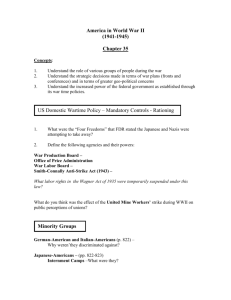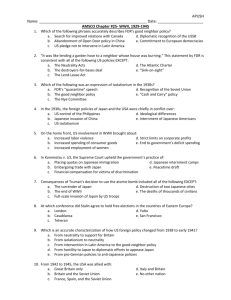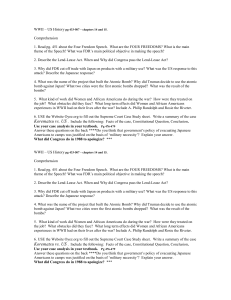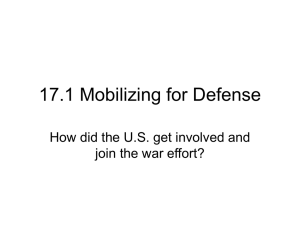Ch. 26 Reading Guide
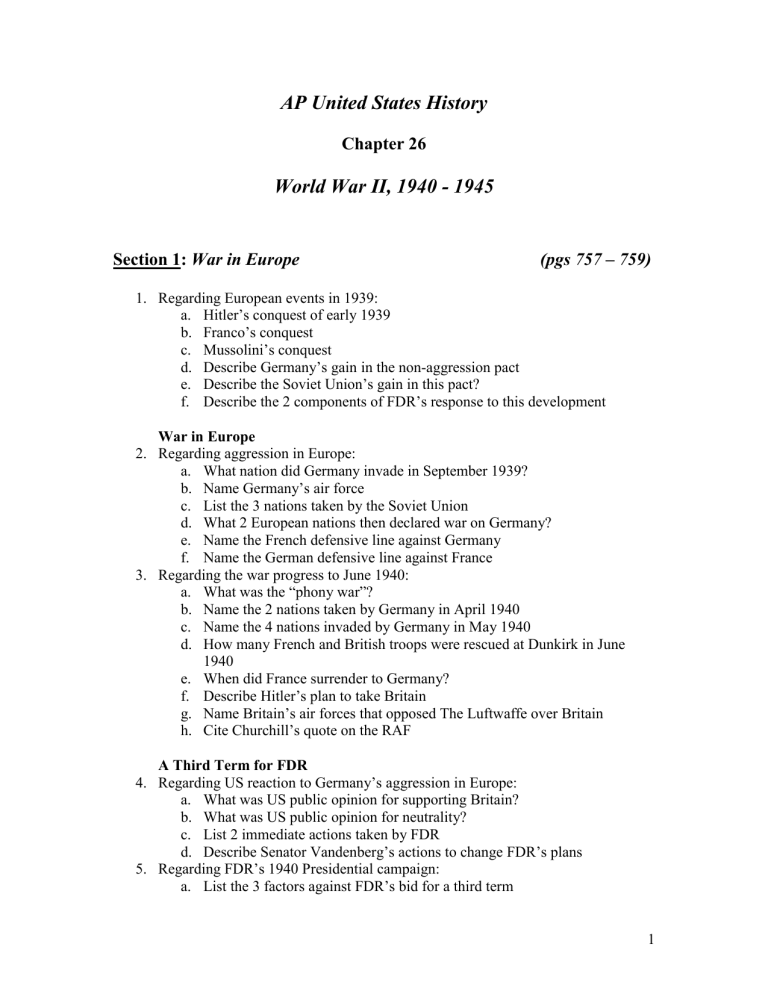
AP United States History
Chapter 26
World War II, 1940 - 1945
Section 1: War in Europe
(pgs 757 – 759)
1.
Regarding European events in 1939: a.
Hitler’s conquest of early 1939 b.
Franco’s conquest c.
Mussolini’s conquest d.
Describe Germany’s gain in the non-aggression pact e.
Describe the Soviet Union’s gain in this pact? f.
Describe the 2 components of FDR’s response to this development
War in Europe
2.
Regarding aggression in Europe: a.
What nation did Germany invade in September 1939? b.
Name Germany’s air force c.
List the 3 nations taken by the Soviet Union d.
What 2 European nations then declared war on Germany? e.
Name the French defensive line against Germany f.
Name the German defensive line against France
3.
Regarding the war progress to June 1940: a.
What was the “phony war”? b.
Name the 2 nations taken by Germany in April 1940 c.
Name the 4 nations invaded by Germany in May 1940 d.
How many French and British troops were rescued at Dunkirk in June
1940 e.
When did France surrender to Germany? f.
Describe Hitler’s plan to take Britain g.
Name Britain’s air forces that opposed The Luftwaffe over Britain h.
Cite Churchill’s quote on the RAF
A Third Term for FDR
4.
Regarding US reaction to Germany’s aggression in Europe: a.
What was US public opinion for supporting Britain? b.
What was US public opinion for neutrality? c.
List 2 immediate actions taken by FDR d.
Describe Senator Vandenberg’s actions to change FDR’s plans
5.
Regarding FDR’s 1940 Presidential campaign: a.
List the 3 factors against FDR’s bid for a third term
1
b.
What issue ultimately gave FDR the public’s approval for a third term? c.
Who were the Democratic candidates for President and Vice-President? d.
Who were the Republican candidates for President and Vice- President? e.
Describe FDR’s “lease” plan offered to Britain. f.
Give FDR’s electoral count against Wilkie’s in the 1940 election
Section 2: The End of Neutrality
(pgs 759 – 762)
6.
Regarding the US Lend – Lease program: a.
Describe how the program worked b.
List the 3 leading products produced by the US
7.
Regarding the American First Committee: a.
Name the 3 leading voices of the AFC b.
What was the position of the AFC toward the war in Europe? c.
Describe the controversial suggestions of the remark made by Charles
Lindbergh
8.
Regarding public opinion by 1941: a.
What was US public opinion toward going to war with Germany? b.
Describe the 2 Congressional actions taken in March 1941
9.
Regarding the war progress by early 1941: a.
Describe the actions of Hitler toward the Soviet Union by June 1941 b.
What did FDR offer Stalin c.
Describe US aid to the Soviet Union between 1941 – 1945 d.
How did FDR justify this aid to the Soviet Union
10.
Regarding the Atlantic Charter of August 1941: a.
List the 2 leaders who established the charter b.
List the 4 basic principles of the charter c.
Describe the US policy of “active defense” d.
Name the US destroyer sunk in October 1941
The Road to Pearl Harbor
11.
Regarding Japanese aggression in Asia: a.
Describe the “rape of Nanking” b.
Describe the Panay incident c.
List the 5 regions affected by Japan’s 1938 “Greater east Asia Co-
Prosperity Sphere” d.
List 2 actions taken by FDR against Japan in 1940 e.
What was Japan’s response to FDR’s embargo? f.
Describe Japanese movements in April 1941 g.
List FDR’s 2 responding actions against Japan h.
Describe the diplomatic requests of Japan i.
Describe the conditions established by FDR toward Japan
12.
Regarding the Japanese attack on Pearl harbor: a.
Who led the Japanese fleet? b.
List 6 naval components of the Japanese naval fleet
2
c.
What was the date of the Japanese attack on Pearl Harbor? d.
List 3 components of US military losses e.
What proved to be a vital mistake made by the Japanese bombers?
13.
Regarding US knowledge of the Japanese attack on Pearl harbor: a.
What was the Marshall announcement of November 27 th
? b.
What threat did the US perceive existed in Hawaii? c.
Describe US responsibility for the attack
14.
Regarding the US entry into World War II: a.
Describe Congressional action on December 8, 1941 b.
Describe German action on December 11, 1941
Early Defeats
15.
Regarding the Axis Powers gains by late 1941: a.
Monthly Allied shipping lost to German submarines b.
Nazi gains on the Eastern front c.
Rommel’s gains in Northern Africa d.
List 8 Asian regions gained by Japan e.
List 4 leading economic commodities gained by Japan through conquest
16.
Regarding the US defeat in the Philippines: a.
Who was the US Commander in the Philippines? b.
Where did the US and Filipino troops seek refuge from the Japanese? c.
Name the US Commander who finally had to surrender to the Japanese in the Philippines d.
What was the political result of the “Bataan Death March”?
Section 3: The Homefront
(pgs 762 – 765)
War Production
17.
Describe the general American attitude and opinion of supporting the war effort.
18.
Regarding the US mobilization for World War II: a.
What was the function of the War Production Board? b.
Describe the 2 incentives given to businesses in order to speed production c.
What was the overall increase of industrial production? d.
What was Ford’s production of the B-24 “Liberator” bombers? e.
Explain Secretary of War Stimson’s justification of huge business profits
19.
Regarding industrial production during the war: a.
What the increase in the GNP? b.
Describe the increase of the national budget c.
Describe the volume produced of the following items:
1.
Planes
2.
Tanks
3. Anti-aircraft guns
4. Merchant shipping
20.
Regarding the US financing of World War II: a.
List the 4 components of the 1942 Revenue Act b.
What % of the funding came from taxes? c.
What % of the funding came from government borrowing? d.
What was the level of the national debt by 1945?
3
e.
Who served as the US Secretary of Treasurer?
21.
Regarding wartime job opportunities: a.
How did factories respond to wartime production demands? b.
What 3 groups in society now had new job opportunities extended to them? c.
Describe the rise in wages and salaries d.
Describe the rise in per capita income e.
Describe the shift of wealth in the US during the 1940’s
Making Do
22.
Regarding wartime rationing: a.
What was the function of the Office of Price Administration? b.
List 7 items commonly rationed c.
What was the amount of gasoline rationed each week d.
What was FDR justification for Major League Baseball to continue its baseball schedule? e.
List the 2 landmark baseball achievements of 1941 f.
How did the war affect night baseball? g.
How did the war effort affect spring training? h.
How did Major League Baseball show veteran appreciation? i.
Who was the first major league player drafted by the military? j.
What affect did the military draft have on Major League Baseball?
Section 4: Opportunity and Discrimination
(pgs 765 – 770)
Women and the War Effort
23.
Describe the 3 different migrations that occurred within the United States during
World War II
24.
How many Americans were directly or indirectly associated with the armed forces?
25.
Regarding the role of women during World War II: a.
How many women entered defense related jobs? b.
What % of these women were married? c.
What was the government’s monthly allotment to service families? d.
Name the fictitious female character representing those women who worked in the war effort e.
List 3 reasons why employers rationalized paying women nearly 40% less than men f.
What was the expectation of female workers to do after the war was over?
“Double V” Campaign
26.
Regarding the role of blacks during World War II: a.
List the 2 components of the “double v” campaign b.
Describe A. Phillip Randolph’s plan to protest discrimination c.
Explain FDR’s Executive Order # 8802 d.
What was the function of the Federal Employment Practices Committee?
4
e.
What was the estimated number of blacks that moved out of the South? f.
List the 4 leading states that employed workers for war industries g.
What was the % of blacks employed by the War Industries? h.
What was the % of women employed by the War Industries by 1941? i.
List 3 US cities that experienced racial violence during the war
27.
Regarding the California “Zoot suit” riots”: a.
List the 2 sources blamed for the outbreak of violence b.
Describe a “zoot suit” c.
Describe the “bracero” program d.
Describe the monthly migration rate of Hispanics to Los Angeles area e.
Give the number of Hispanics that served in the armed services
28.
Regarding racial discrimination within the military service: a.
Coast Guard b.
Marines c.
Navy d.
Army e.
List 4 southern states were blacks were murdered in the service f.
Name the successful all black air force squadron
29.
Regarding the emerging civil rights movement: a.
What was the focus of the black news media? b.
Describe the increase of membership to the NAACP c.
What was the focus of the Congress of racial Equality
Internment of Japanese Americans
30.
What group of Americans experienced the worst wholesale discrimination during
World War II?
31.
Regarding Japanese internment camps: a.
Describe the Alien Registration Act b.
What group was never lifted from this act c.
List the 3 leading states with the highest Japanese populations d.
Describe Executive Order # 9066 e.
Describe Executive Order # 9102 f.
List the 5 leading states where relocation centers were established g.
By June 1942, how many Japanese were interned
32.
Regarding the following US Supreme Court rulings: a.
Hirabayashi v United States (1943) b.
Korematsu v United States (1944) c.
Endo v United States (1944) d.
List 3 conclusion of the 1981 Congressional investigations on why
Japanese internment took place e.
Describe the 1988 reward issued to survivors of Japanese internment
5
Section 5: The Grand Alliance
(pgs. 770 – 776)
North Africa, Stalingrad, and the Second Front
33.
In which arena of World War II did FDR view as the most important?
34.
Regarding the Allied plan to invade Germany: a.
List 3 reasons why the British were reluctant to confront Germany head on b.
What plan did the Soviet Union advocate?
35.
Regarding the Battle of the Atlantic (1942): a.
Describe German “wolf packs” b.
List 4 military inventions that worked to deter German submarines
36.
Regarding the North Africa campaign (1942 – 1943): a.
Name the 2 African nations invaded under Operation Torch b.
Leader of the American forces c.
Leader of the British forces d.
Leader of the German forces e.
Where were German forces finally halted?
37.
Regarding the Battle of Stalingrad: a.
Describe the actual military fighting tactics in Stalingrad b.
List the 4 forces confronting the German Army c.
Why is the Battle of Stalingrad considered the turning point in World War
II?
38.
Regarding the Casablanca Conference (January 1943): a.
Name the 2 Allied leaders present b.
Describe the Allied plan of attack adopted at the conference? c.
Why were the Soviet suspicious of Allies
39.
Regarding the Italian campaign (1943): a.
When did Sicily fall to the Allies? b.
After Sicily fell, what became of Mussolini? c.
Who led the US forces in the Italian campaign? d.
Who did the new Italian government then declare war upon? e.
When was Mussolini captured and killed? f.
What did the Soviets suspect of the Allies over the surrender of Italy? g.
What did Stalin decide to do with his forces as he moved westward across
Europe?
40.
Regarding the Tehran Conference (November 1943): a.
List the 3 Allied members present b.
List the 4 major issues discussed at the conference
Normandy Invasion (D-Day)
41.
Regarding the planning stage of D-Day: a.
What commander led the D-Day forces b.
How many men were employed in the invasion? c.
Describe the amount of war supplies needed for the invasion d.
How many planes were used in the invasion? e.
Describe Germany’s Atlantic Wall
6
42.
Regarding the D-Day Invasion: a.
On what day was D-Day? b.
How many troops landed ashore on D-day? c.
How many troops had landed in Europe by August 1944? d.
When was Paris liberated?
43.
Regarding the US drive eastward to Germany: a.
When did US troops reach German borders? b.
What was the significance of the Battle of the Bulge? c.
Describe what became of the German will d.
What became of Hitler in April 1945 e.
What had Hitler named his mighty German empire?
Facing the Holocaust
44.
Regarding the Holocaust: a.
List 5 groups of Europeans systematically murdered the Nazi regime between the 1930’s and 1940’s b.
When did the US first learn of the Jewish concentration camps? c.
Explain FDR’s view of the best way to help European victims of Nazi terror d.
When was the Refugee Board established? e.
Describe the 2 possible bombing strategies available to American air forces
Section 6: The Pacific War
(pgs. 776 – 778)
45.
Regarding Japan’s belief in military victory over the United States: a.
Who was the Japanese admiral in charge of Japanese naval forces? b.
List 2 American advantages recognized by Japan c.
Describe Japanese belief in America’s will to fight and win
Turning the Tide, Closing In on Japan
46.
Regarding United States military campaign against Japan: a.
List the 2 early US naval victories against Japan that proved American determination to win. b.
Who led US naval forces in the Pacific Theatre? c.
Who led US Army forces in the Pacific Theatre? d.
List 3 common types of military engagements in the Pacific war e.
What was the significance behind the US victory at Guadalcanal? f.
Describe the US campaign of “leapfrogging” to Japan g.
List 4 major US naval victories by July 1944 h.
Why was the victory of Okinawa so crucial to US war planes against
Japan i.
Describe the Japanese kamikaze practice
47.
Regarding US losses at Okinawa: a.
US deaths b.
US wounded
7
48.
Regarding total losses during World War II: a.
List the 5 leading nations who suffered the highest deaths in combat
Section 7: A Change in Leadership
(pgs 778 – 781)
49.
Regarding the 1944 Presidential elections: a.
Who were the Democratic President and Vice-Presidential candidates? b.
Who was the Republican candidate? c.
What term was this for FDR to be elected to?
Yalta Accords
50.
Regarding the Yalta Conference (February 1945): a.
List the 3 Allied leaders attending b.
List the 2 terms agreed to by the Soviet Union c.
Name the new international peace keeping body agreed upon to be established after the war
51.
Regarding Soviet demands: a.
List 3 reasons why Stalin felt justified in his demands b.
List the 3 stiff demands of Stalin on the Allies
52.
Regarding US – British response to Stalin: a.
List the 2 biggest concerns of the Allies b.
Explain Britain’s moral concern for Poland’s future
53.
Regarding the Yalta Accords: a.
List the 4 military zones Germany was to be divided into b.
What did the nations decide on with Berlin c.
List the 3 “loose” agreements with the Soviet Union d.
Explain the Declaration of a Liberated Europe e.
Give 2 examples were Stalin had broken his promise
Truman in Charge
54.
Regarding the death of FDR: a.
What was the date of his death? b.
What was the cause of death?
55.
Regarding Harry S. Truman: a.
When and where was Truman born? b.
Describe his World War I service c.
When was he first elected to public office? d.
What corrupt Kansas City political boss was Truman associated with? e.
What year was Truman elected to the US Senate? f.
Cite Truman’s comment to the press upon swearing in
56.
Regarding Truman’s handling of the Soviet Union: a.
What advice was he given by Eleanor Roosevelt and Henry Wallace? b.
What advice did he receive from Averell Harriman c.
Who was the Soviet ambassador to the United States? d.
Explain Truman’s threat he made to the Soviet Union
8
57.
Regarding the Potsdam Conference (July 1945): a.
List the 3 allied leaders present b.
Describe the 2 main issues discussed at the conference c.
What event disrupted the conference? d.
Describe the “cold” relationship between Truman and Stalin
The Atomic Bomb
58.
Regarding US attempts at ending the war in Japan: a.
Describe the LeMay Raids against Japan b.
How many Japanese cities were targeted for bombing
59.
Regarding the atomic bomb: a.
Who originally ordered the research and development of the atomic bomb? b.
Who were the 2 leading scientists on the atomic project? c.
What was the code name for the development of the atomic bomb? d.
Where were the 3 leading laboratories located?
60.
Regarding the planned usage of atomic weapons: a.
What was the advice from the Intern Committee? b.
What 4 Japanese cities did the Target Committee recommend? c.
On what date did the US successfully detonate an atomic bomb? d.
What was the diplomatic fear of using the atomic bomb against Japan?
61.
Regarding Truman’s order to drop the atomic bomb: a.
How did Truman justify his decision? b.
What 2 Japanese cities were targeted for the drop? c.
What were the 2 dates of bomb drops and the date of Japanese surrender?
62.
Regarding Truman’s decision to use the atomic bomb: a.
Describe the 3 possible controversial motivations for him to want to use the atomic bomb against Japan
63.
Regarding the ending of World War II: a.
When was V-E Day? b.
When was V-J Day? c.
What was the total human loss in World War II? d.
Cite Mac Arthur’s statement at the surrender signing
Conclusion
64.
Regarding changes in the US as a result of World War II: a.
Why is World War II considered a watershed event in US History? b.
What was the biggest change that took place in the US as a result of World
War II? c.
List 4 permanent changes in American foreign policy d.
List 5 permanent changes in American domestic policy
9
